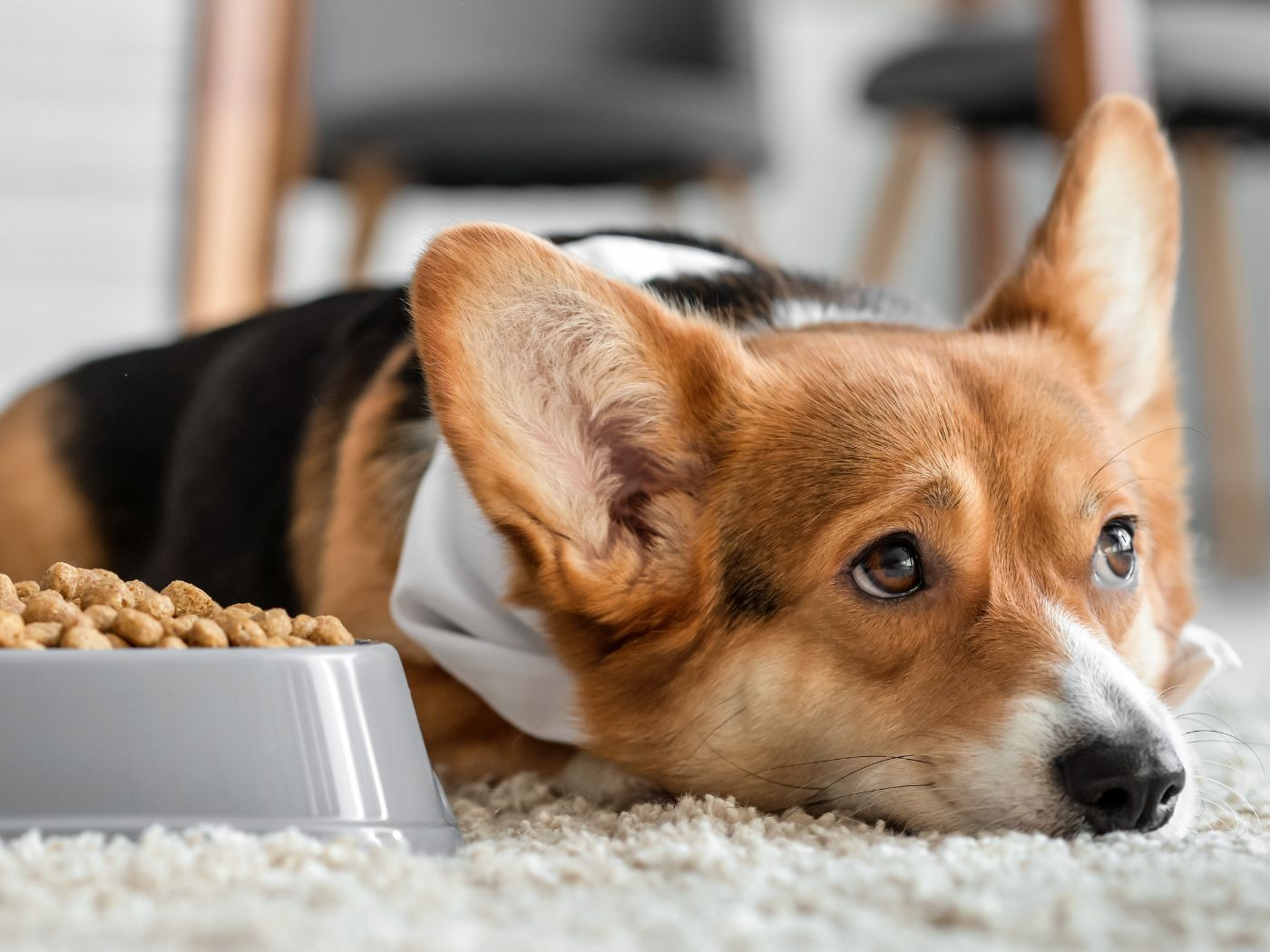Picky eating is a common and stressful challenge for dog owners. In part one of our series on fussy eaters we looked at common health issues and feeding mistakes that can lead to fussy eating. If your dog is in good health and you've tried the strategies in part one to no avail, then here are some further tips and techniques to encourage your picky eater to gobble up their food.
1. Strategically Timed Exercise
Before we move on to more complex strategies this little routine change up can be surprisingly successful for some dogs! Exercise is great for building up an appetite and may help encourage a picky eater to devour their dinner. Try a good walk, run or play session before a meal, but allow a 15 minute break between exercising and feeding for your dog’s tummy to settle.
2. Improve the Smell
Another simple change to try is to warm your dog’s food up to body temperature. Dogs are exquisitely sensitive to smell. Heating their food improves the aroma and stimulates their appetite. Just stir a small amount of hot water through your kibble and leave it to sit for a few minutes before offering the meal to your dog.
3. Enrichment feeding
Enrichment feeding takes advantage of your dog’s natural curiosity and playfulness to make mealtimes a positive experience. Many picky eaters really benefit from making dinner time more interesting, as oftentimes they just need help getting started, but these enrichment feeding ideas are great for all dogs!
Enrichment activities
The ‘big deal’ game.
This game works with a surprising number of dogs, especially those that just need a little bit of encouragement to get started with eating. The idea is to get them excited about eating and to make them think that their main meal is a reward! Plus, many dogs actually do like working for their food.
Begin a short session of your dog’s favourite tricks (eg: Shake, High Five, Roll Over) just before mealtime. At the start reward them with their usual treat, then segue into intermittently using some of their kibble as a reward. When your session is done immediately put down your dog’s bowl. A lot of picky eaters will go straight into eating a food that they would normally reject simply because they are still so excited from being rewarded during play time. Once they are eating heap on the praise!
This is also a really good activity to use when introducing your fussy eater to a new food.
The ‘scatter and scavenge’ game
This game takes advantage of your dog’s natural scavenging instinct to encourage them eat their food, but it can take a few sessions to get this going well.
Start this game by using treats to reward a few tricks as above, then add in the kibble as a reward. Now go back to using the treat, but drop it on the ground for your dog to ‘scavenge’. Do this a few times, then try it with some kibble, mixing up the treats and the kibble as above.
Once your dog is responding to this you can start scattering the treats/kibble further away. Once you’re at this level you’re best to do this outside as it can get messy!
Most dogs enjoy scavenging their food like this. You can build up to feeding a whole meal this way and it is a great enrichment feeding activity for all dogs. My dog loves this and when the weather is dry he usually gets his evening meal scatter fed outside on the lawn.
Enrichment feeders and toys
Some fussy eaters prefer playing with their food over eating it! You can harness this play drive to encourage better eating by using one of the many puzzle feeders, snuffle mats and licky mats on the market.
You can even make your own version of these. Some favourites at our house include popping some kibble in a cardboard roll with the ends twisted up, an egg carton with the top closed down and a plastic bottle without the lid on. Obviously supervise them and don’t let them eat the cardboard or the plastic!
4. Adding a topper to their dog food
Before you consider changing your picky eater’s main diet, it is worth trying a meal topper or booster. A topper is simply anything you add to your dog’s diet to improve its palatability. Adding a topper often works well with those pets who just need a bit of help getting started on their dinner.
Unless you are using a topper that is already formulated as a complete and balanced diet, and you are planning on using this strategy long term, then it is important to make sure any toppers make up less than 10% of the overall daily calorie intake of your dog, so as not to unbalance your dog’s diet. You also need to make sure that you don’t inadvertently feed too many calories overall by adding in a topper. If possible, calculate this out, but regardless I always recommend a weight check before and then 2 weeks after making any dietary change!
Some popular meal toppers include:
- High value treats (ideally a meat-based treat)
- Raw or cooked meats (avoid very fatty cuts of meat, especially in breeds prone to pancreatitis)
- Fresh fruit or veges
- Pet bone broths or gravies
- Fish oil or other tasty supplement at recommended daily dose
- Chopped dog roll (possyum seems to be a favourite!)
- Canned food
Just remember to stir any ‘topper’ through your dog’s food to reduce the chances of them picking out the topper and leaving the rest of their meal behind!
5. Try a different food
If you have ruled out any health issues and common feeding mistakes, tried all the tricks above and nothing is working, then it may be time to admit defeat and try a different food! But, constantly changing foods can have the perverse consequence of making your picky eater even fussier, if not done well. What we don’t want is to end up in an endless loop of trying one new food after another. I have seen this happen too many times and it is really stressful for both dog and owner. So, you need to go into this with a plan!
The first thing I always recommend, especially with small dogs, is to try a food that contains the same protein as your current food, but is a different texture. This helps rule in or out whether your dog has a texture preference. This is more common in cats, but dogs can develop this too. Eating a canned food is a very different sensory experience to crunching up a kibble. Try a canned/sachet food, dog roll, air dried diet or complete and balanced freeze dried or frozen raw diet made from the same protein as your current diet and see what your dog’s reaction is.
If a change in food texture doesn’t help, then it is time to look for another flavour of food and see if they have a flavour preference. Unfortunately, many dog foods are now made with 3 or 4 different proteins (this is a particular bug bear of mine that I will save for another blog very soon!), which makes this a bit challenging. Look for the first meat ingredient on the ingredient list as this is probably contributing most of the flavour. If your dog has been turning his nose up at a food with chicken as the main meat protein then try a food with fish, lamb, beef or venison as its main protein instead.
For picky dogs a fish-based dog food (such as our Ocean Fish food!) is a really good option as fish is not a commonly fed protein source. This means that for many dogs it is a new ‘flavour’ and they are unlikely to have developed a food aversion to it (see blog one of this series for info on food aversions). Fish-based diets also tend have a stronger and more enticing smell for dogs, whilst still being non offensive to human noses.
6. Tips for successfully introducing a new food to your dog
The number one most important thing is not to upset your dog’s tummy by changing foods too abruptly and too frequently. You don’t want to put them off the new food before they’ve even had a real chance to get used to it! This is particularly important if changing from one food type to another, such as raw to kibble and vice versa and if changing to a diet with very different macronutrient levels within a diet type, for example a low fat kibble (8%) to a higher fat kibble (20%) or a low protein kibble (18%) to a high protein kibble (38%).
When transitioning your dog to a new food, you need to do it slowly, keeping the majority of your dog’s food as its original diet for the first few days then gradually transitioning onto the new food as shown below.
- Days 1 – 2– 75% current food. 25% New food
- Days 3 – 4– 50% current food. 50% New food
- Days 5 – 6– 25% current food. 75% New food
- Day 7– 100% New food
With a picky eater, a dog you know has a sensitive tummy, or if it’s a significant change in diet, then you may want to go even slower and introduce over a 14 day period. It may be slow, but your dog will be more likely to stick with eating their new food in the longer term if you follow this process.
I used to always say to people to mix the new food in with the old food when transitioning. This works well with dogs that will happily eat anything. But with picky eaters I now tend to recommend that you introduce any new food you are trying as a ‘high value treat’ for a start. If your dog thinks their new food is a treat they are far more likely to accept it. Taking this approach also takes a lot of pressure off you for a start. Dogs pick up on our anxiety easily and we don’t want them thinking we are worried about their new food.
Make a big deal when you open the packet and introduce it in a way that your dog is going to think it is a treat!
This may be by feeding it as part of a trick training session, popping it in their puzzle feeder, or using it in the ‘big deal’ or ‘scatter and scavenge’ games above. It doesn’t matter if you’re feeding way less than that 25% for the first few days the aim is just to get them enthusiastic about their new food before we begin increasing it. Once they’re super keen then you can start mixing it in with their old food and working it into your daily feeding regime.
Conclusion
Hopefully these tips and tricks, gathered from years of experience helping owners of fussy dogs in my veterinary practice, can help your solve your dog’s picky eating issues! If you still have questions or need extra help please reach out via email at: paula@geniuspetfood.co.nz
Keep an eye out for my next blog which will cover my ‘rule of 3’ for protein selection – which will also explain why it drives me so nuts when I see pet food companies making diets that contain 3 or even more different proteins in the one food!



